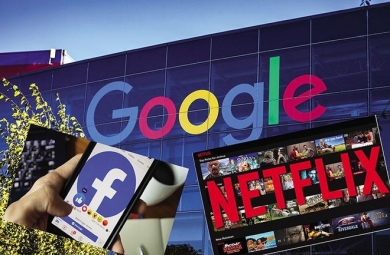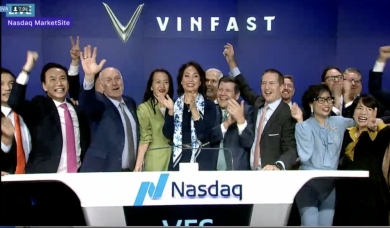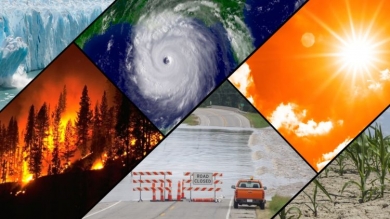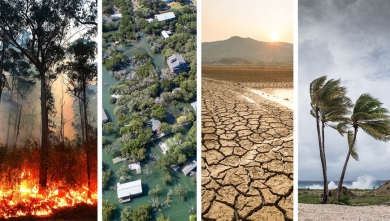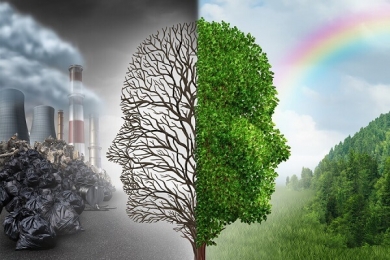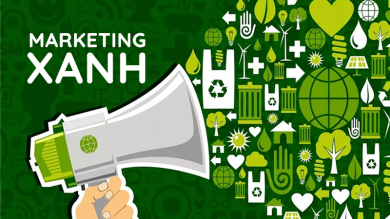Civilizations can coexist across boundaries, but when “civilization power” is claimed as universal and conflated with national interests, the world becomes a dangerous place.

A frozen stretch of the Liaohe River in Panjin, China, on Feb. 6. (Yu Haiyang/China News Service/VCG via Getty Images)
The economic and technological convergence of globalization did not lead to a singular cosmopolitan order, but to a great divergence, in which prospering emergent nations, most notably China, once again attained the wherewithal to chart a path forward based on their own civilizational foundations. Economic and technological strength engenders, not extinguishes, cultural and political self-assertion.
This development has led Bruno Maçães to argue we are seeing the return of “civilization states,” such as Vladimir Putin’s Russia and Xi Jinping’s China, that are pushing back against the universalist claims of a liberal world order.
In this series, we asked several thinkers, including Shashi Tharoor, Zhang Weiwei, Pallavi Aiyar and George Yeo, to assess Maçães’s argument.
— Nathan Gardels, Noema editor-in-chief
SINGAPORE — “Never before in history have two civilizational realms challenged each other at the global level where the extent of their integration has itself become the terrain of contestation,” Noema editor Nathan Gardels has rightly written with respect to China and the American-led West in the 21th century.
In order to grasp where this world we live in might be headed, we need to look through a meta-frame at the past history of how the world’s great civilizations have coexisted or come to blows when bound up with the assertion of cultural identity through state power.
In the past century of political discourse, the subject of civilizations was often discussed in terms of the ancient giving way to the modern, especially the Islamic, Indic and Sinic civilizations that have been forced to modernize, and the most the ancients can hope for is to preserve core artifacts and values in the new national cultures that are emerging. The rest might arouse nostalgia, provide entertainment and end up in museums.
The distinction between culture and civilization is itself ancient. Culture is what every tribe and community developed to affirm its sense of identity. Some cultures established states with clear borders that further nurtured their cultures. Cultures could have originated in communities that were agrarian or pastoral, settled or nomadic, literate or non-literate, and they remained strong and distinctive when people of all classes lived together for long periods of time. States, on the other hand, were led by “men of prowess”: chiefs or priests, princes or kings, even emperors.
Civilization began with the idea that the “civilized” had to confront the “barbaric.” Men of vision set out to find meaning in life beyond their own borders. They ranged from prophets and teachers who inspired those with wealth and power to spread their message to everyone. Their vision could help a powerful state shape a borderless worldview and define the values of a new civilization. If this succeeded, that imperial civilization would bring local and princely states and cultures under its wing. Each civilization was not intrinsically superior to any culture but, together with different cultures, it could expand its footprint, reduce the uncivilized realms and challenge other civilizations.
Where Did Modern Civilization Come From?
The modern civilization originated in Western Europe, where it first emerged when several ancient ones interacted with one another through their states or empires in the Mediterranean. The most important of them were the two that developed out of cultures from the heart of the Eurasian continent by speakers of the Afroasiatic (Semitic) languages who brought Assyrian-Babylonian cultures to the Eastern Mediterranean, and by Indo-European speakers who headed south to Iran and India and west to Europe.
Both types of civilizations were represented by established states that had their own written languages, and both were composites of different mixes of cultures. The best known among the imperial states that fought for supremacy on both sea and land across the Eurasian continent were Alexander’s empire that spread Hellenistic civilization and Augustus’s Roman Empire that conquered all parts of the Mediterranean.
During the centuries of rivalry, each of these imperial civilizations contained local and state cultures, including many that acknowledged the universal vision that the Hellenistic and Roman Emperors claimed to provide. But there were cultures that resisted that claim and offered their own, most notably the Hebrews who inspired what became the Old Testament of the Christian Bible. Despite centuries of persecution, their vision prevailed. When the Roman Emperor Constantine was eventually converted to the Christian faith, that vision was connected thereafter with the Roman Empire in its mission to bring a monotheistic truth to the world.
However, the truth mission did not go unchallenged. The Hebrews and others questioned the unity claimed by Rome. A few centuries later, new believers came out of the Arabian deserts; they not only dominated the southern and eastern Mediterranean but also threatened the rest of Europe, first through their conquests in Anatolia and Iberia and finally by taking the Byzantine capital of Constantinople. With the realm divided for over 10 centuries, the “holy” mission of the Romans lost its centrality. And as the Islamic half of the Mediterranean civilization entrenched itself in northern India and Central Asia, other parts of the world saw it as a separate civilization from what was left in Roman and Byzantine Europe.
Modern civilization is now identified with the Enlightenment. Renaissance Italy and the separation of state and church after the Reformation marked its beginnings, followed by the scientific and secular “modern” against the traditional and backward “ancient.” The vision locked onto the idea of material progress, which inspired several sovereign nations to further their imperial ambitions in the name of what Europe achieved. By the 19th century, it had led to the belief that there was only modern civilization — and all ancient ones were bound for extinction if they did not modernize.
The power of modern civilization grew stronger when the Roman Mediterranean was forced to turn toward the oceans. When that maritime thrust became global, it challenged Islamic ambitions in the Indian Ocean and also inspired the Eastern Orthodox empires to expand over land until the two parts of Christian civilization met in the North Pacific. Both advances served to contain the Islamic mission that was dominant in Central Asia.
“By the 19th century, it was believed that there was only modern civilization — and all ancient ones were bound for extinction if they did not modernize.”
Modern civilization in Western Europe was the story of freeing minds from dogma and privilege and drawing inspiration and wealth from new environments and civilizations that had previously been out of reach. There followed the victory of humanistic imagination and scientific discovery. And maritime networks ensured that industrial capitalism would become the engine to bring progress to all corners of the world.
The new civilization drew fresh inspiration from its Greco-Roman heritage and set aside the constraints of church traditions. The freedom to think led to the right to question and innovate, to devise new paradigms of authority and social order. At the same time, it enabled the mighty modern to push aside the weakening ancient. With their new instruments of power, sovereign nations competed to dominate the world. National empires sped up the demise of all that was ancient by offering modern universal values for all mankind.
But there was a fatal flaw in that development. By the 19th century, when empires ran out of places to dominate, they became rivals that turned on one another, each devising secular ideologies that claimed to act in the best interests of its people. On one side was an emphasis on legal protection for individual freedom and rights. On the other were calls for caring states to side with the poor and weak against the rich and strong. Both couched their quest for hegemony in terms of good versus evil.
The tragedies of the First World War should have been warning enough, but the remaining European empires still wanted nothing less than total victory. It needed another world war to hammer home the lesson that civilization cannot coexist with national empires, which were then replaced by the idea of equal nation-states in a new world order. Here the United States as the least imperial state took on the responsibility of promoting political values that everyone could accept. Former empires and the newly decolonized nation-states agreed to create a different environment where all nations could work together to rebuild modern civilization.
The United Nations has not been an adequate vehicle for managing this task. A gathering of nations defending their cultures and identities cannot be an instrument for bringing about a global civilization. What was established turned out to be but the victors’ compromise. Old ideological challenges survived and carried baggage from the past that would not go away. Also, the surviving ancient civilizations — the Islamic, the Indic and the Sinic — chose to find their own paths to modernization. When the U.S. revived a chastened Western Europe and defeated the Soviet Union in the Cold War, it became the world’s sole superstate. Standing for universal values defined by liberal capitalism at its core, U.S. state power became in effect the guardian of global civilization.
Modernizing Ancient Civilizations
After the European half of the Mediterranean laid the foundations of modern civilization, three ancient civilizations continued on their own paths. It was just over a century ago that they each finally realized that, unless they modernized, their civilizations could end up in the dustbin of history. But they all resisted modernizing the way the West expected. This was because their founding visions had created different kinds of civilizations.
The Islamic experience illustrates what happens when a civilization is divided after centuries of rivalry. Its Arab origins began as a monotheistic duty destined to challenge the Christian vision. After the Crusades against Islam failed and European states became maritime and global, the Islamic states in the Indian Ocean continued to defend a universal vision. But from the point of view of secular Europe, that vision remained ancient and primarily Mediterranean. When the British and French navies took control of the Mediterranean, the Caliphate realm was fragmented and new national states emerged to modernize in their different ways. Today, what Wahhabi Arabs and Iranian ayatollahs want, and what Israel and Palestine stand for, are irreconcilable.
There were Muslim leaders who chose to modernize, like Mustafa Kemal Atatürk in Turkey. New nation-states in Asia, like Pakistan, Bangladesh and Indonesia, as well as those of North Africa, were prepared to master capitalism, science and technology in order to protect their respective national interests and also the monotheistic traditions they still had.
However, some of the faithful decided that nation-states can achieve little and supported borderless organizations to resist the secular heresies that threatened their civilization. Their strategy has been unable to keep the organizations united, but they can still count on some states to give them succor. In the meantime, the spiritual jihad that the civilization offers still has wide appeal, while nation-states continue to modernize against their secular enemies.
Indic civilization had Indo-Aryan roots that were shared with the Indo-European peoples who went west, as well as with the Hellenes and the Iranians who invaded northern India. The Indic metaphysical world of multiple gods was closer to that of the Greco-Roman but did not succumb to the monotheism of the Semitic peoples. Instead of heaven or paradise, it offered many roads to rebirth. It was never an imperial civilization but was founded on the many local states and cultures that were free to choose among the many paths available.
While these polities were no less prone to wars and fierce debates among themselves, Indic civilization was content to offer inspiration to those willing to accept what it had to offer. Its strength was in its deep and varied cultural roots, in the way its ideational and aesthetic inclusiveness enabled the civilization to withstand mundane threats.
“By the 19th century, when empires ran out of places to dominate, they became rivals that turned on one another.”
Large parts of the Indian sub-continent came under Islamic rule for centuries, but most of its people did not accept the monotheistic vision it brought. The Indic remained largely Hindu and did not need the state to assert its traditions. This remained true when it later confronted the Europeans who came to its shores by sea. And, at the peak of British Indian power after the mid-19th century, the civilization was still able to maintain its holistic condition.
Indian leaders were quick to modernize when they decided to build a secular nation-state. They knew that the modernization they accepted was rooted in the West, but they still sought to determine how they could preserve its Hindu heritage.
The Sinic civilization’s roots were found a long way from the civilizations inspired by the Semitic and Indo-European speakers moving south and west from Central Asia. Until the 19th century, it had never been threatened by another civilization. Several nomadic conquerors had ruled the Chinese imperial state but treated its civilization with respect.
Sinic civilization emerged from dozens of local cultures of the Yellow River plains when early rulers chose officials to help them govern wisely. With a unique literacy, they created a tianxia (“all under heaven”) vision, but numerous states struggled for supremacy. Eventually, one of those states, the Qin, defeated the others to establish a united tianxia. Its successors, the Han and Tang dynastic empires, spread their civilization to the neighboring Korean and Japanese states.
The civilization was built on its written language, its governance records and the body of philosophical and literary texts commonly represented by Confucius and his disciples. It first encountered another civilization when Indic Buddhist missionaries impressed both the Han elites and the Turkic-Mongolic invaders that had divided the Chinese empire. For centuries, the dynastic empires embraced this Buddhist vision and welcomed others, like the Nestorian Christian, the Zoroastrian and Manichean, the Hebrew and the Islamic. But only Buddhism offered the Chinese what they lacked and was totally internalized into the Sinic civilization shared by the Korean, Japanese and Vietnamese.
One other experience that consolidated later Sinic civilization was the way it survived after the Chinese state was totally conquered first by the Mongols and then the Manchus. The civilization survived Mongol rule and restored a Confucian orthodoxy. This became so strong that the three great Manchu emperors of the 18th century reaffirmed this orthodoxy to enable Qing imperial power to be the face of Sinic values. In that way, the civilization became indistinguishable from the state when it was confronted by the imperial modern of the 19th century.
Why The Chinese State Threatens The West
U.S. state power leads the West as the sole guardian of modern civilization. Islamic resistance to modernization does not depend on state power but on an ancient living faith. This the U.S. finds manageable. The Indic drive to develop national power based on its ancient civilization is still a work in progress. The U.S. can offer to shape its progress. In any case, both have turned to their ancient faiths to help them defend against the secular modern from the West, but are in no position to reject it.
China began to lose its leadership position in Sinic civilization when Japan turned away to modernize by following the West. It became even more alone after both Korea and Vietnam became colonies. The Qing dynastic state was never a nation. When it fell, the republic that remained could not pretend to be a civilization.
This is why the Chinese experience of two revolutions (1911 and 1949) has been so painful. Both represented a willingness to reject their ancient civilization. Japan’s invasion ended the Kuomintang experiment with liberal capitalism. When Maoist China found itself under the shadow of Soviet hegemony, it abandoned state socialism. During the era of Deng Xiaoping’s “reform and opening up,” when Chinese leaders were modernizing with great determination, American leadership was reassuring and not threatening.
Now that China has succeeded in modernization, it is charting a future on its own terms, turning to a redefined socialism that is framed to appeal to its civilizational heritage. This is a decisive departure from the American view of how the world should work. Especially as the U.S. has retreated to a nationalistic posture of “America First,” Donald Trump doing so in rhetoric and Joe Biden in fact, China no longer finds the confident claims of the U.S. as the leading civilization convincing.
“China no longer finds the confident claims of the U.S. as the leading civilization convincing.”
While the present Chinese regime rejects key parts of what the U.S. claims to be universal — individual over collective rights, free expression, independent judiciary and electoral government — they are not yet clear where the heritage of “Chinese characteristics” will lead. China knows what it will not do, but having modernized in the Western mold, it too has become nationalistic in the way it thinks the West has been. It is pushing back as a self-proclaimed “civilizational state.” Fearing the different road China is forging as a challenge to all that its global leadership has stood for, the U.S.-led West thus also casts the contest as a defense of modern liberal culture rooted in the values of the Enlightenment, which it has always seen as universal.
If the U.S. were confident that it will succeed in promoting the values of modern civilization, it might tolerate a strong Chinese national culture that seeks to challenge it. But when it is domestically riven, lacking inner confidence and cohesion, where many within the West itself seek a return to traditional values they see as threatened by secular modernism, that portends a different future.
Civilizations can coexist across boundaries as they have for centuries. But when “civilization power” is claimed as universal and conflated with national interests, or when it is invoked in the name of national empire, the world becomes a dangerous place.
When what is regarded as vital in the life of a people is challenged by others who are intertwined economically and technologically in one global system, there is little room for compromise and tolerance, upon which coexistence rests.
BY WANG GUNGWU From NoemaMag


